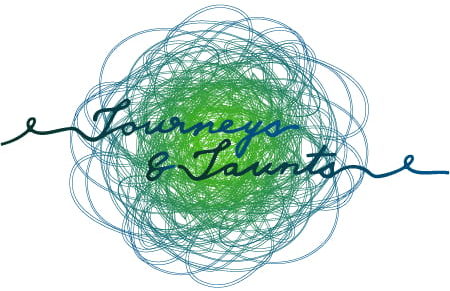My friend Kenny always says: ”In China, they just call it food.” Sorry, Kenny, but there is no such thing as JUST when it comes to Chinese food. On top of regional cuisines – usually, people cite 8 big types, with dozens if not hundreds of subgenres – China also boasts a great number of, let’s call them ‘ethnic’ cuisines. One of those ‘ethnic’ cuisines that is prevalent in the entire country is Muslim (or halal) food.
Muslims in China
Calling this cuisine ‘ethnic’ is a bit dubious, since the only thing the main two Muslim groups in China – Uyghurs and Hui – have in common is their religion, but let’s not split hairs, okay?
The Uyghurs are descended from Turkish tribes and mainly live in the Northwest of China. They have their own autonomous region (Xinjiang) and are one of the 55 ethnic minorities recognized in the PRC. They often look more European than Chinese, and have their own language, which is very closely related to Turkish.
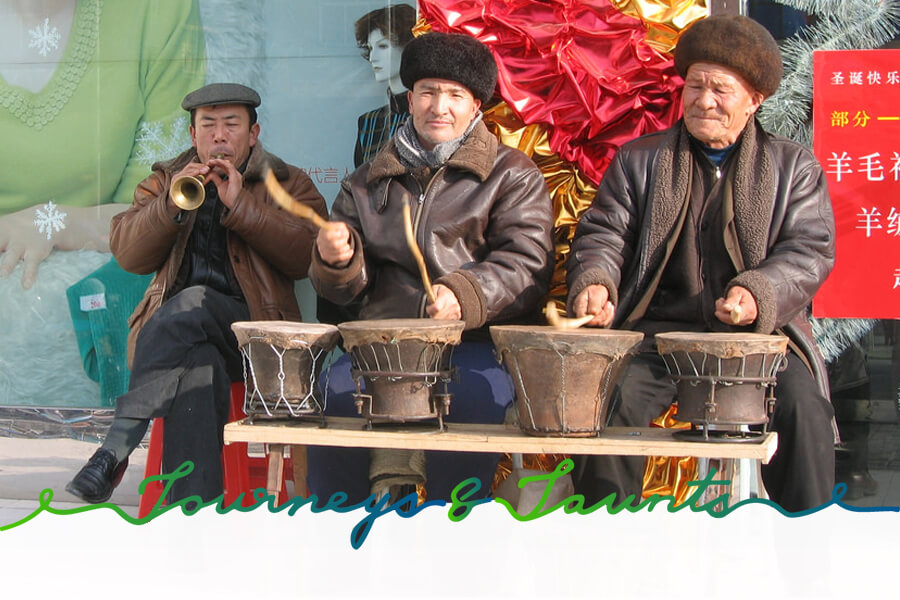
Actually, one of our German-Turkish friends used to tease me that Muslim Street in Shenyang was the only place in the city where he could communicate more comfortably than I. But that’s a different story for another day…
The Hui are ethnically Han Chinese who practice Islam, the biggest Muslim group in China, and also one of the 55 recognized ethnic minorities. They speak Mandarin and are easily distinguished from other Chinese when they wear Muslim head coverings (hijab for women, little white caps called taqiyah for men).
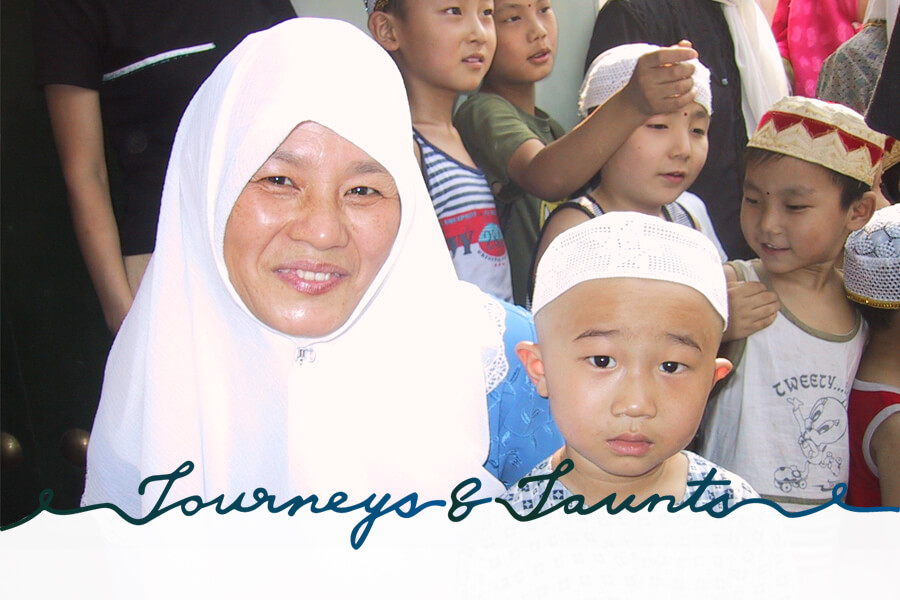
Many young Hui, however, wear the same type of clothing as their Han peers. Often, one of the ways that you can distinguish people of the Hui ethnic minority from other Chinese is by their surnames. Ma, for instance, is a famous Hui surname, derived from Muhammad.
What makes Muslim food different?
For religious reasons, Muslims do not eat pork or animal byproducts such as blood. They are also forbidden alcohol and products containing it. Any animals they eat should be slaughtered according to Islamic law.
Since pork is the most consumed meat in China – if it just says 肉 (ròu in pinyin, ‘meat’ in English) on a menu somewhere, btw, the meat in question is normally pork – Hui who are observant Muslims tend to have it rough when it comes to food. So, they and the Uyghurs have opened restaurants all over China that only serve halal food.
To distinguish these halal restaurants from others, the place in question carries a sort of seal (usually to be found on the sign at the main entrance) that reads 清真 (qīngzhēn in pinyin, meaning Islamic in English). They are usually green on white or blue on white and look something like this:

Also, Muslim restaurants, especially Hui ones, favor the colors (dark) blue and white for their logos, signs, and often also for their interior design. If there is lots of blue and white flashing at you from a restaurant, you have probably stumbled across a Hui eatery. Or a place serving traditional Bavarian fare. But one simple look at the menu should tell you which one it is…
Hui cuisine
In the case of the Hui, halal food regulations have led to a sort of parallel development of Northern Chinese cuisine, with the main difference being that many dishes have substituted the ubiquitous pork for beef or sometimes lamb.
Lanzhou Hand-Pulled Beef Noodles
A good example of Hui cuisine are Lanzhou hand-pulled beef noodles. Lanzhou is the capital of Gansu Province and has a significant Hui population. If you don’t have the money and/or time to travel there, though, you can have these delicious hand-pulled noodles in other parts of China as well. In Shenyang, for instance.
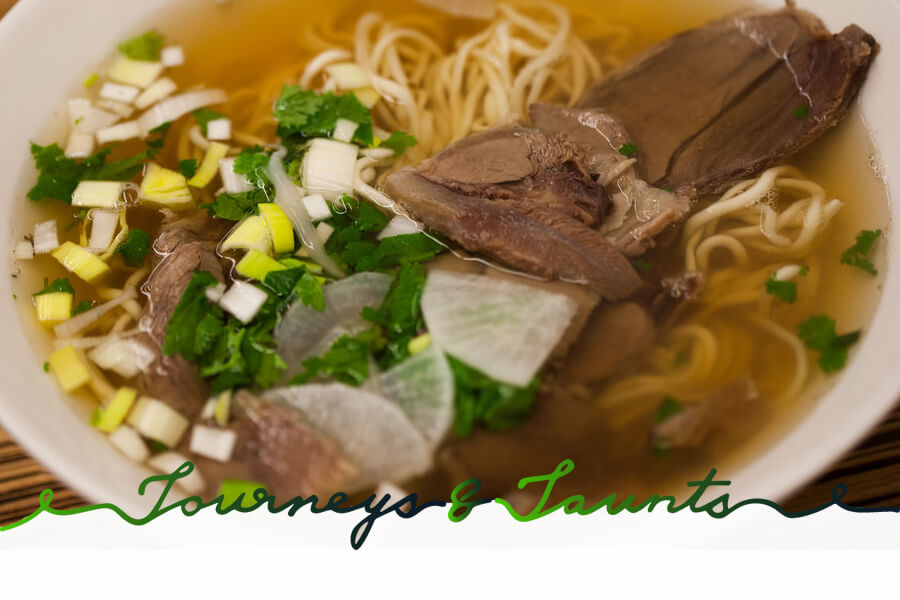
Lanzhou noodles are very similar in look and texture to other pasta in Northern China, but they come in a clear broth of lamb or chicken. This is not one of the flashier halal dishes, but I love the sweetish turnip with a hint of bite that bobs in the soup along with the noodles, the big chunks of meat and the clear broth. And the noodles. But I guess that goes without saying.
In Shenyang, 清真.一品道兰州牛肉拉面 (qīngzhēn yīpǐndào lánzhōu niúròu lāmiàn in pinyin, Halal Yipindao Lanzhou Hand-pulled Beef Noodles in Chinglish) is a good place to have Lanzhou Beef Noodles. This fast-foodish place is part of the food court located on B1 of the Middle Street Happy Family Mall. You enter through the mall’s eastern entrance and go down one floor to find it. The closest subway station to the mall would be Zhongjie (Middle Street) station (中街 in Chinese, zhōng jiē in pinyin).
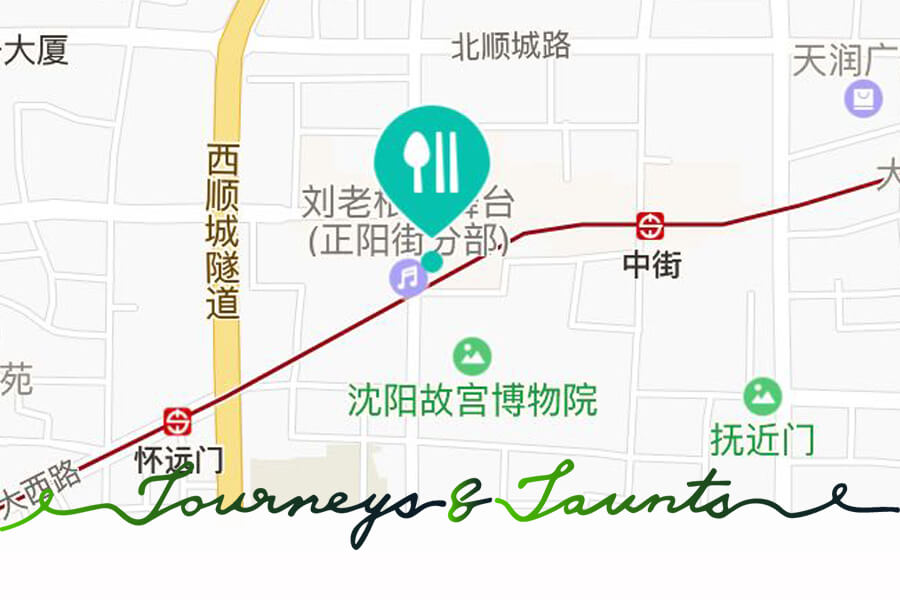
Halal Shaomai
Dumplings are another staple of Hui cuisine in Shenyang. In Northeastern China, it is difficult to escape dumplings, so the Hui who live here serve them as well. There is a kind that looks like a cross between an unfinished baozi (from which it takes its shape) and a jiaozi (from which it takes the wrapper). This delicacy comes steamed, with a beef or mutton filling. They are called 清真烧麦 (qīngzhēn shāomài in pinyin, halal Shaomai OR halal dimsum OR halal dumpling with meat and vegetable filling, OR… in Chinglish) and they are YUMMY!

I like to eat them at 西关小馆 (xīguān xiǎoguǎn in pinyin) in Wen’an Road (文安路 in Chinese, wén’ān lù in pinyin), which is the smallish street behind the Sofitel (marked, for some reason, as the Marriott in the map below…). You can find the restaurant by looking for its dark blue and white signage. Remember how I said dark blue and white were a good place to start looking for halal food? Wen’an Lu is gentrifying fast, though, so I don’t know how long this little shop/restaurant will remain open.

Uyghur cuisine
Where Hui cuisine is mostly very close to the food in some parts of Northern China, the Uyghur cooking resembles that of the Uyghur’s Turkish ancestors. Lots of mutton, lots of cumin, lots of flavors. Some specialties include meat skewers, flatbread, and ‘big plate chicken’.
Meat Skewers
Meat skewers (串儿 in Chinese, chuànr in pinyin) are no original Uyghur creation. Putting meat, other body parts and *gasp* even vegetables on sticks and grilling them is sort of a Chinese national sport. But both the Hui and the Uyghurs are Olympic-level chuànr makers. Plus, at Muslim places, the seasoning tastes totally different than at booths held by Han Chinese, so I’ve included chuànr here.
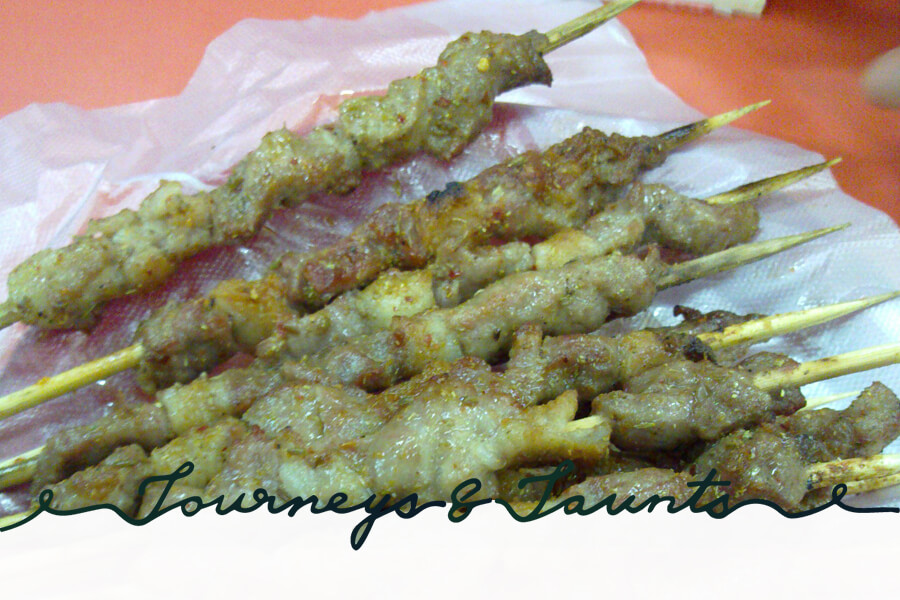
They are absolutely heavenly, though not exactly cholesterol-friendly, as meat and pieces of fatty tissue alternate. The fat makes them super-crispy and flavorful.
Speaking of flavors – each shop/booth/BBQ operator seems to have their own blend of spices and/or marinade, so trying out different vendors until you find your personal favorite is an absolute must!
Flatbread
The best accompaniment to chuànr is flatbread (馕 in Chinese (and boy, was I unhappy when I had to learn how to write that one!), náng in pinyin). It is a big, round flat bread with a raised border – sort of like a pan pizza crust – and decorated with a delicate pattern that is pressed into the dough before baking with pins. On top of that pattern goes a generous helping of sesame seed that give it that little something extra.
Totally unrelated side note: bought in bulk and frozen, náng are a perfect base for a quick dinner fix. Dump some tomato sauce, leftover veggies, cold cuts and cheese on them, and turn them into pizza. But I digress…
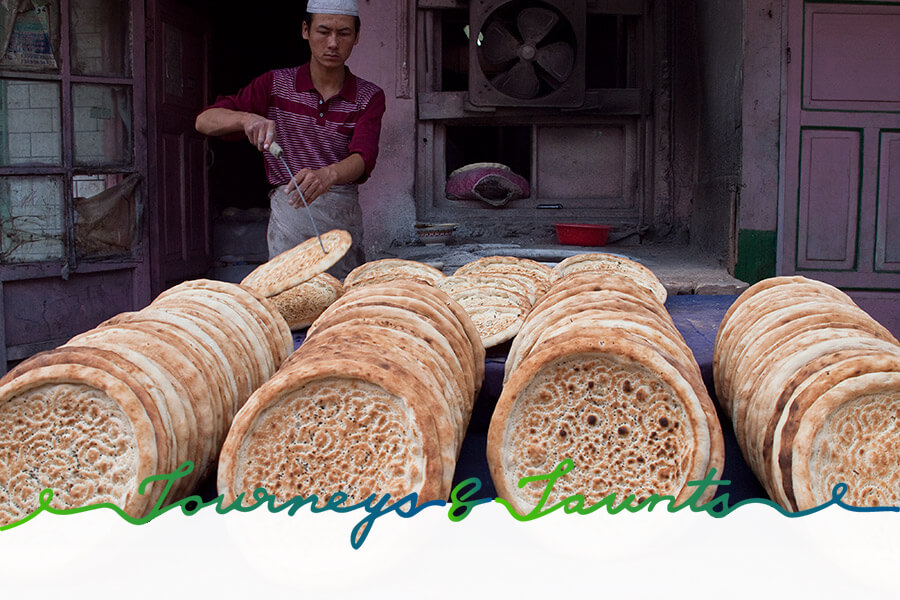
Náng is baked stuck to the inside of a barrel-shaped oven. The bakers have it down to an art ‘rescuing’ the breads just when they are about to fall off because they are baked through. The process of shaping the dough, pressing the pattern into it, and the baking itself is quite a spectacle. So, if you get a chance, watch it with your phone ready to record the whole thing.
Big Plate Chicken
Another favorite Uyghur dish of mine is big plate chicken (大盘鸡 in Chinese, dà pán jī in pinyin). Is it the huge portion that makes this specialty so irresistible? Is it the incredibly wide noodle (that’s right, the entire dish usually just has ONE noodle, which is so long it fills a whole big plate on its own)? The pieces of delicately spicy chicken? The potatoes? The smattering of other vegetables? I don’t know why I like it so much, but I do.

Actually, it is probably the fact that the noodle is called 裤带面 ( kùdài miàn in pinyin), which means ‘belt noodle’. As in the belt that holds up your pants. How can you not love a dish with a ‘belt noodle’ in it? Just try it, I dare you.
Muslim Street
For all the Uyghur specialties mentioned above, along with several others and some Hui food for good measure, the place to go in Shenyang is ‘Muslim Street’. This little street, more of an alley, actually, is full to the brim with halal restaurants. While it is still warm enough outside, you can sit at rickety tables on ricketier chairs and cheerfully eat your way through the menus one by one.

Muslim Street is called 清真路 in Chinese (qīngzhēn lù in pinyin) and located in Shenhe District, directly east of Shifu Guangchang (Government Square) metro station (市府广场 in Chinese, shìfǔ guǎngchǎng in pinyin).
NOTE: I am neither a Muslima nor an Islamic scholar, so please forgive me if the religious information in here is not 1000% accurate. I’d be happy to learn more, though, so please leave me comments below the article and I will update it accordingly.
